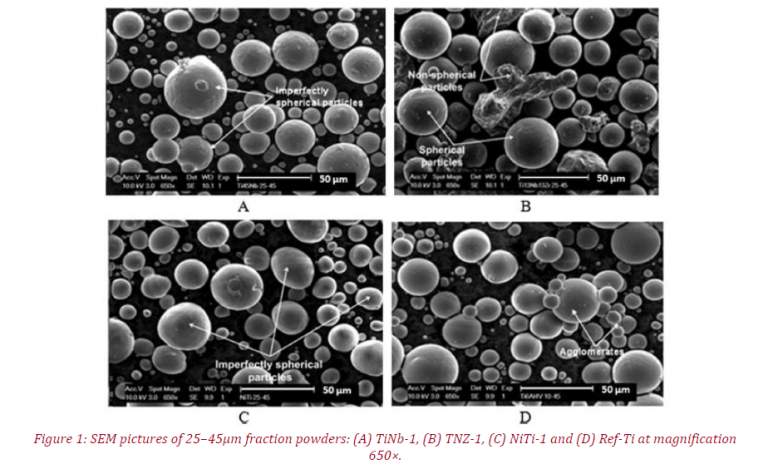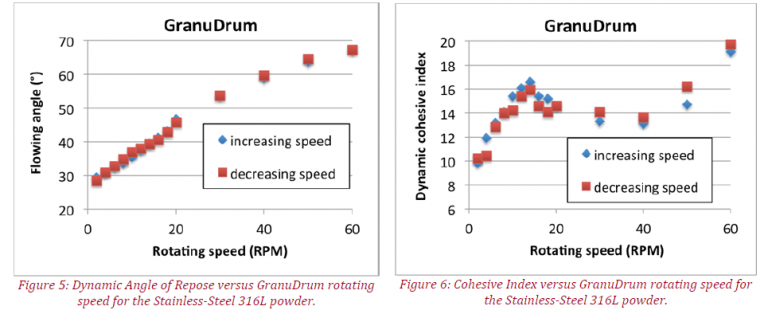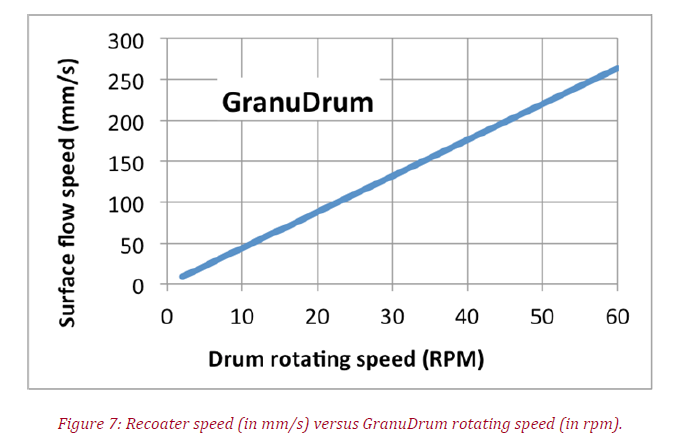Additive manufacturing
Understanding and Improving Powders Spreadability For a Recoater Process in Additive Manufacturing
Granular materials and fine powders are widely used in industrial applications.
To control and to optimize processing methods, these materials have to be precisely characterized.
Introduction
Theoretical Framework
Granular materials and fine powders are widely used in industrial applications.
To control and to optimize processing methods, these materials have to be precisely characterized.
The characterization methods are either related to the properties of the grains (granulometry, morphology, chemical composition, …) and to the behaviour of the bulk powder (flowability, density, blend stability, electrostatic properties, …). However, concerning the physical behaviour of bulk powder, most of the techniques used in R&D or quality control laboratories are based on old measurement techniques.
During the last decade, we have updated these techniques to meet the present requirements of R&D laboratories and production departments. In particular, the measurement processes have been automatized and rigorous initialization methods have been developed to obtain reproducible and interpretable results. Moreover, the use of image analysis techniques improves the measurements precision.
In SLS (Selective Laser Sintering), SLM (Selective Laser Melting) and EBM (Electron Beam Melting) techniques, successive thin layers of powders are created with a ruler or with a rotating cylinder. Each layer is partially sintered or melted with and energy beam (laser or electron beam). The layer thickness defines a vertical resolution. Therefore, a thin-layer leads to a better resolution.
In order to obtain this effect, the powder is as fine as possible. Unfortunately, when the grain size decreases, the cohesiveness increases and the flowability decreases. Moreover, the powder becomes more and more sensitive to moisture. Thus, a compromise between grains size and flowability must be found.
The quality of the part build with Additive Manufacturing (AM) is directly related to the powder flowing properties. The flowability must be good enough to obtain homogeneous successive powder layers. Different recent publications have evidencing that the classical flowmeters are unable to give pertinent information about powder flow behaviour in powder-bed-based AM.
In shear cell tested and classical rheometers, the existence of a compressive load is incompatible with the free surface flow used in AM devices. However, the measurement method based on the rotating drum is a good candidate because the powder flow is analysed precisely at the powder/air interface without any compressive load. Moreover, the rotating drum geometry allows studying the natural aeration of the powder during the flow.
In this application note we will show that the probability to obtain waves during the layer formation is proportional to the Cohesive Index measured by the GranuDrum instrument. Moreover, it can predict the optimal ruler (recoater) speed to obtain a homogeneous layer.
GranuDrum
The GranuDrum instrument is an automated powder flowability measurement method based on the rotating drum principle. A horizontal cylinder with transparent sidewalls called drum is half filled with the sample of powder. The drum rotates around its axis at an angular velocity ranging from 2 rpm to 60 rpm. A CCD camera takes snapshots (30 to 100 images separated by 1s) for each angular velocity. The air/powder interface is detected on each snapshot with an edge detection algorithm. Afterwards, the average interface position and the fluctuations around this average position are computed. Then, for each rotating speed, the flowing angle (also known in the literature as ‘dynamic angle of repose’) αf is computed from the average interface position and the dynamic cohesive index σf is measured from the interface fluctuations.
LEARN MORE ABOUT THE GRANUDRUM
In general, a low value of the flowing angle αf corresponds to a good flowability. The flowing angle is influenced by a wide set of parameters: the friction between the grains, the shape of the grains, the cohesive forces (van der Waals, electrostatic and capillary forces) between the grains. The dynamic cohesive index σf is only related to the cohesive forces between the grains. A cohesive powder leads to an intermitted flow while a non-cohesive powder leads to a regular flow. Therefore, a dynamic cohesive index closes to zero corresponds to a non-cohesive powder.
When the powder cohesiveness increases, the cohesive index increases accordingly.

In addition to the measurement of both the cohesive index (CI) and the flowing angle αf as a function of the rotating speed, GranuDrum allows to measure the first avalanche angle and the powder aeration during the flow.
Determination of powders spreadability
Powders descriptions
Four titanium powders were selected for this application note. They have different size and shape (cf. Figure 1 and Figure 2, Yablokova et al., 2015) and they are named TiNb-1, TNZ-1, NiTi-1 and Ref-Ti:

.png)
These powders were specifically selected because two of them have bad spreadability for a recoater process (NiTi-1 and TiNb-1), thus the powders layer created is not homogeneous (with waves and irregularities, cf. Figure 3 A.). However, Ref-Ti and TNZ-1 after the recoater operation create a flat surface with no irregularities (i.e. with good process ability, i.e. spreadability, cf. Figure 3 B.):

GranuDrum Analysis
These powders were tested by the GranuDrum instrument. The results show the evolution of the Cohesive Index obtained using the rotating drum method as a function of the rotating speed. The measurements have been performed with an increasing rotating speed (from 2 to 20 rpm):

LEARN MORE ABOUT THE GRANUDRUM
The previous Figure shows that two different rheological behaviour can be highlight., TiNb-1 and NiTi-1 with a high Cohesive Index and thus, with low process-ability (creating non-homogeneous powder layer). However, Ref-Ti and TNZ-1 powders have a small Cohesive Index, which means that their flowability & spreadability will be better than other samples.
Finally, the GranuDrum instrument allows to compare one sample to another and to define a threshold (24 in this case) bellow which it is possible to have a successful Selective Laser Melting (SLM) process for Additive Manufacturing process.
Optimisation of the recoater speed
Powder used
The sample used is a commercial Stainless-Steel 316L powder (from Hogänäs) with a primary particle size close to 50μm.
GranuDrum analysis
This powder was tested using the GranuDrum instrument. The dynamic Angle of Repose and the Cohesive Index were plotted as a function of the GranuDrum rotating speed. The measurements have been performed with an increasing rotating speed (from 2 to 60rpm) followed by a decreasing rotating speed (from 60 to 2rpm):

Figure 5 shows that the Dynamic Angle of Repose (also known as Flowing Angle) increase linearly with the process velocity. Thus, this parameter is not the perfect one to improve the recoater speed.
Figure 6 investigates Cohesive Index variations for different rotating speeds. For a speed between 2 to 18rpm, the Cohesive will increase almost linearly. Between 18 to 40rpm it will drop and finally increase for a speed above 40rpm.
LEARN MORE ABOUT THE GRANUDRUM
These results are highly interesting, because they allow us to say that the powder flowability will be better at 40rpm than 18 rpm. If one wants to reach the best recoater speed with a good spreadability, it is better to have a recoater process close to 40rpm. Moreover, the linear speed of the drum wall (which correspond to the average flowing speed at the powder/air interface layer according to the mass conservation law) should be compared with the recoater speed.
Then, the range of speeds considered during the GranuDrum measurement should be selected accordingly. The next plot presents the surface flow speed as a function of the drum rotating speed to help selecting the proper rotating speed:

Therefore for the Stainless-Steel powder, the optimum recoater speed is close to 175mm/s (40rpm).
Conclusion
The GranuDrum instrument allows to:
- ✓ Select the best powder in terms of “spreadability”
- ✓ To optimise the recoater speed for a given powder, to have the optimum process speed and the best powder spreadability
Bibliography
Cascade of granular flows for characterizing segregation, G. Lumay, F. Boschin, R. Cloots, N. Vandewalle, Powder Technology 234, 32-36 (2013).
Combined effect of moisture and electrostatic charges on powder flow, A. Rescaglio, J. Schockmel, N. Vandewalle and G. Lumay, EPJ Web of Conferences 140, 13009 (2017).
Compaction dynamics of a magnetized powder, G. Lumay, S. Dorbolo and N. Vandewalle, Physical Review E 80, 041302 (2009).
Compaction of anisotropic granular materials: Experiments and simulations, G. Lumay and N. Vandewalle, Physical Review E 70, 051314 (2004).
Compaction Dynamics ofWet Granular Assemblies, J. E. Fiscina, G. Lumay, F. Ludewig and N. Vandewalle, Physical Review Letters 105, 048001 (2010).
Effect of an electric field on an intermittent granular flow, E. Mersch, G. Lumay, F. Boschini, and N. Vandewalle, Physical Review E 81, 041309 (2010).
Effect of relative air humidity on the flowability of lactose powders, G. Lumay, K. Traina, F. Boschini, V. Delaval, A. Rescaglio, R. Cloots and N. Vandewalle, Journal of Drug Delivery Science and Technology 35, 207-212 (2016).
Experimental Study of Granular Compaction Dynamics at Different Scales: Grain Mobility, Hexagonal Domains, and Packing Fraction, G. Lumay and N. Vandewalle, Physical Review Letters 95, 028002 (2005).
Flow abilities of powders and granular materials evidenced from dynamical tap density measurement, K. Traina, R. Cloots, S. Bontempi, G. Lumay, N. Vandewalle and F. Boschini, Powder Technology, 235, 842-852 (2013).
Flow of magnetized grains in a rotating drum, G. Lumay and N. Vandewalle, Physical Review E 82, 040301(R) (2010).
How tribo-electric charges modify powder flowability, A. Rescaglio, J. Schockmel, F. Francqui, N. Vandewalle, and G. Lumay, Annual Transactions of The Nordic Rheology Society 25, 17-21 (2016).
Influence of cohesives forces on the macroscopic properties of granular assemblies, G. Lumay, J. Fiscina, F. Ludewig and N. Vandewalle, AIP Conference Proceedings 1542, 995 (2013).
Linking compaction dynamics to the flow properties of powders, G. Lumay, N. Vandewalle, C. Bodson, L. Delattre and O. Gerasimov, Applied Physics Letters 89, 093505 (2006).
Linking flowability and granulometry of lactose powders, F. Boschini, V. Delaval, K. Traina, N. Vandewalle, and G. Lumay, International Journal of Pharmaceutics 494, 312–320 (2015).
Measuring the flowing properties of powders and grains, G. Lumay, F. Boschini, K. Traina, S. Bontempi, J.-C. Remy, R. Cloots, and N. Vandewall, Powder Technology 224, 19-27 (2012).
Motion of carbon nanotubes in a rotating drum: The dynamic angle of repose and a bed behavior diagram, S. L. Pirard, G. Lumay, N. Vandewalle, J-P. Pirard, Chemical Engineering Journal 146, 143-147 (2009).
Mullite coatings on ceramic substrates: Stabilisation of Al2O3–SiO2 suspensions for spray drying of composite granules suitable for reactive plasma spraying, A. Schrijnemakers, S. André, G. Lumay, N. Vandewalle, F. Boschini, R. Cloots and B. Vertruyen, Journal of the European Ceramic Society 29, 2169–2175 (2009).
Rheological behavior of β-Ti and NiTi powders produced by atomization
for SLM production of open porous orthopedic implants, G. Yablokova, M. Speirs, J. Van Humbeeck, J.-P. Kruth, J. Schrooten, R. Cloots, F. Boschini, G. Lumay, J. Luyten, Powder Technology 283, 199–209 (2015).
The influence of grain shape, friction and cohesion on granular compaction dynamics, N. Vandewalle, G. Lumay, O. Gerasimov and F. Ludewig, The European Physical Journal E (2007).

